Collect white boletus. Mushroom boletus: description with photo
The cap of the cap boletus may have a diameter of about 16-20 cm. Initially, it is hard and convex, but in the process of growth acquires a pillow shape. This mushroom grows very quickly, increasing in size by 4-5 cm during the day, and by 10 g in weight. It becomes fully mature after 6 days, after which the aging process starts. A boletus boletus lives about 10 days.
Regarding the color of brown boletus, the hats can be from gray-olive to almost black. Their legs can be up to 15 cm in length and up to 3.5 cm in thickness. At the bottom of the legs are usually thickened, covered with scales brownish, gray or black. Mushrooms have a dense white flesh, which when cut becomes a slightly pinkish tint.

Where do boletuses grow and when do they appear?
In nature, there are as many as 12 species of boletus (common, marsh, pinkish and others). They love the bright parts of the forest, because they usually focus on glades, edges, as well as along ravines, paths and roads. If summer is rich in mushrooms, birch trees grow under even very young birches.
In the people there are different names for birch bark, among which - birch, black or gray mushroom, grandmother, obobek, podobabok, blackhead, spikelet. They begin to collect them from the very beginning of summer until mid-autumn. A particularly rich crop succeeds in rainy summers.
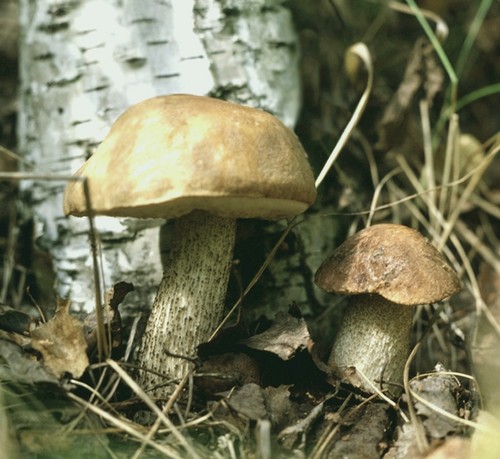
Benefit and harm
As you already understood, wild boletus is edible, mushroom pickers put it in second place after white. True, as a result of heat treatment, its flesh darkens. It is used in a wide variety of culinary recipes. It is rich in a variety of vitamins, minerals, acts as an antioxidant and removes all kinds of toxins from the body. Boletus mushrooms are useful for the heart, kidneys, nervous and hematopoietic systems, skin and mucous membranes, as well as the musculoskeletal system.
The danger of boletus is that it is very similar to a mushroom, called bile and inedible. In addition, they can cause allergies. In no case should you collect boletus growing in industrial areas or near highways. After all, mushrooms are an excellent sorbent, and therefore absorb everything harmful that is around them, which can cause poisoning.
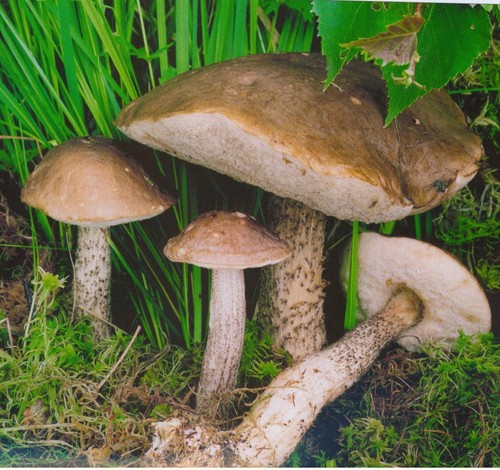
It is important that you carefully study the characteristics of varieties of boletus, as well as photos of mushrooms, before going on a “silent hunt”, which will protect you from tangling them with poisonous crops.
Boletus is an excellent mushroom. You can fry, boil, dry and store for the winter. The mushroom has a calm taste and aroma, it is very easy to recognize in the forest, it is easy to collect and cook. A few simple recommendations from Culinary Eden will help you prepare a delicious lunch or dinner to celebrate the finding of boletus.
The mushroom is growing in the deciduous forests, mainly in the birch. Mushrooms come across in parks and young shoots of birches near forests, like the edges of clearings, overgrown old paths in bright mixed forests and along the edge of ravines. A boletus tiller appears at the end of May simultaneously with oils and whites, or a little earlier. The birch tree loves warmth and grows where the sun warms up the soil with mycelium well.
The boletus has four varieties: ![]()
Ordinary
. The black
. Swamp or white
. Turning pink
The most valuable is the common boletus, it is found most often and has the best taste among relatives. The common boletus has a cap up to 15 cm in diameter, light brown (in young) and dark brown (in mature). The pulp is white, dense, not changing color. It occurs in birch forests, at the edges of glades, in 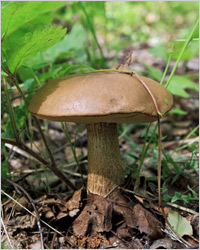 young birch trees. An ordinary birch bark has all the advantages of an edible mushroom: it has a pleasant smell and excellent taste. Very good for frying, suitable for drying and pickling.
young birch trees. An ordinary birch bark has all the advantages of an edible mushroom: it has a pleasant smell and excellent taste. Very good for frying, suitable for drying and pickling.
The black birchbark has a hat with a diameter of 5-9 cm dark brown or black on a leg with black scales. It grows from July to September in damp places, along the edge of swamps, in pine trees, in the section of pine and deciduous forest. The fungus is edible, although less valuable due to its loose structure.
Swamp or white boletus grows in summer and autumn along the edge of swamps. It can grow in mixed, overgrown with moss forests, swampy birch forests. The hat reaches 15 cm in diameter, a convex pillow-shaped with a light pale brown skin. On the cut, the flesh does not change color, the taste and smell are weakly expressed. The leg is thin, elongated. Taste is worse than that of an ordinary boletus.
The pinkish birchbark has a cap up to 15 cm in diameter, pillow-shaped, thin leg and skin color from gray-brown to dark brown. The foot often has a thickening or bending towards a more illuminated area. The pulp is white, dense, slightly pinkish at the cut.
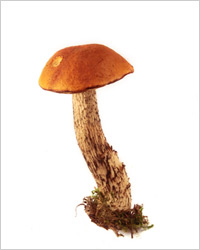 The first collection of birch trees coincides with the flowering of mountain ash - in late May, early June. The period coincides with the earing of rye, for which this mushroom is called a spikelet in some areas. The next period is during the flowering of linden, lasting, like the first, a short time. The third period begins in mid-August and lasts until late autumn.
The first collection of birch trees coincides with the flowering of mountain ash - in late May, early June. The period coincides with the earing of rye, for which this mushroom is called a spikelet in some areas. The next period is during the flowering of linden, lasting, like the first, a short time. The third period begins in mid-August and lasts until late autumn.
The main rule when collecting any mushrooms: if in doubt, don’t take it. The birch tree has a poisonous "double" - gall mushroom, in which the tubular layer under the hat is pinkish, and the incision in the air turns red. In addition, bile mushroom tastes very bitter. Even one bile mushroom is enough to ruin a whole pot edible mushrooms - be careful!
The birch bark is not inferior in taste. the best mushroomsfor example to white. The only drawback of the boletus is that it darkens with any treatment. The color of the mushroom becomes almost black, which does not affect the taste in any way, but can confuse a cook who is unfamiliar with this property. Food lovers adore hats and ignore hard legs. But if you are not afraid of the stiffness and fiberiness of the meat of the mushroom legs - use them too, for example, in soup or to create mushroom sauce.
 Frying. It is believed that the boletus is ideal for frying. Especially in combination with other mushrooms. For best results, fry the mushrooms as soon as possible after harvesting. In extreme cases - the day after collection (mushrooms should be kept in the refrigerator at this time). It is advisable to make a mix of different mushrooms. For example, boletus, white and chanterelles or butter. In this case, heterogeneous mushrooms create microcontrasts of taste, a noble bouquet of aromas, and differences in the density of different mushrooms only enhance a pleasant experience. Vegetables are well combined with mushrooms in frying. For example, potatoes, zucchini, pumpkin, carrots, onions. Before frying, peel the mushrooms from twigs, grass and earth, cut off the parts of the legs that are rough or eaten by forest insects. Worm mushrooms can be soaked in salted water, but if the yield allows, use only mushrooms without wormholes.
Frying. It is believed that the boletus is ideal for frying. Especially in combination with other mushrooms. For best results, fry the mushrooms as soon as possible after harvesting. In extreme cases - the day after collection (mushrooms should be kept in the refrigerator at this time). It is advisable to make a mix of different mushrooms. For example, boletus, white and chanterelles or butter. In this case, heterogeneous mushrooms create microcontrasts of taste, a noble bouquet of aromas, and differences in the density of different mushrooms only enhance a pleasant experience. Vegetables are well combined with mushrooms in frying. For example, potatoes, zucchini, pumpkin, carrots, onions. Before frying, peel the mushrooms from twigs, grass and earth, cut off the parts of the legs that are rough or eaten by forest insects. Worm mushrooms can be soaked in salted water, but if the yield allows, use only mushrooms without wormholes.
Cooking. Boletus can be boiled and served cold with dressing from garlic, olive oil and lemon. Cold boiled boletus are very good with boiled potatoes with a slice of butter sprinkled with fresh dill. For cooking, mushrooms are cleaned, cut off dirty or damaged places, worms are soaked in salt water or thrown away. Usually boiled boletus is boiled in two waters. In the first - to a boil and a little more, then move to another container with boiled water and cook for 15-20 minutes.
Drying. It is very important that the mushrooms selected for drying are of the best quality: without wormholes or damage. Young birch trees are dried whole, threaded through a thread, mature cut into large pieces. It is dried in the open air, but not in the sun, if it is very hot, and in an oven or oven if conditions do not allow drying in the air. The optimum oven temperature is about 50 degrees. To do this, turn on the minimum fire and fully open the door.
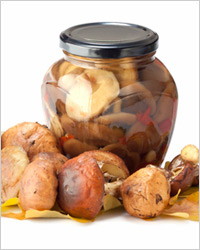 Pickling or pickling. Marinating from salting is different in that vinegar is used in the liquid used to fill the mushrooms. When salting, only salt and spices are used. Use only one type of mushroom in the workpiece; do not mix different types.
Pickling or pickling. Marinating from salting is different in that vinegar is used in the liquid used to fill the mushrooms. When salting, only salt and spices are used. Use only one type of mushroom in the workpiece; do not mix different types.
Compatibility
In dishes, boletus are well combined with:
. Buckwheat
. Perlovka
. Potatoes
. Onions
. Cabbage
. Carrots
. Lentils
. Peas
. Pepper
Brown mushrooms, like other mushrooms, are great for stuffing in pies, pizzas, rolls, homemade bread or noodles (if chopped). It is advisable to prepare the mushroom filling in advance, that is, lightly boil or fry the mushrooms before laying in the pie.
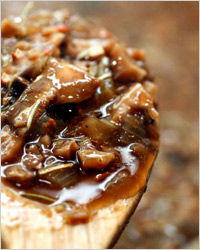
Ingredients:
50 g of dried mushrooms or 300 g of fresh mushrooms,
3 glasses of water
1 tbsp. a spoon of flour
1 onion,
2 tbsp. tablespoons of vegetable oil.
Cooking:
Soak dry mushrooms for 3 hours, fresh boil without salt. Dilute the flour with 1 tablespoon of oil, fry until brown, add 2 cups of mushroom broth and simmer for 15 minutes under the lid. Chop the onion, fry with 1 tablespoon of oil, add the boiled finely chopped mushrooms, fry a little more and put in the sauce, add salt and let it boil for another couple of minutes.
 Mushroom hodgepodge
Mushroom hodgepodge
Ingredients:
500 g of fresh mushrooms
1 kg of cabbage,
1 pickle,
1 onion,
2 tbsp. tablespoons of tomato paste,
1 teaspoon sugar
2 tbsp. tablespoons of oil.
Cooking:
Chop the cabbage and simmer in a pan with the addition of water and oil for 30-40 minutes. Peel the mushrooms, chop finely, boil for 10-15 minutes, then fry in oil. Put the mushrooms in a bowl. In the same pan, fry the chopped onions, add the mushrooms and chopped cucumber back. Salt and pepper. Put another half of the stewed cabbage in another pan, transfer the mushrooms and cover with the rest of the cabbage. Sprinkle with oil and put in an oven preheated to 200 degrees for 10-15 minutes. Serve with lemon.
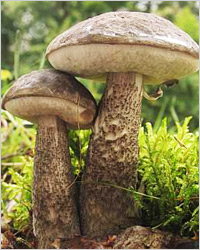 Mushrooms in sour cream
Mushrooms in sour cream
Ingredients:
500 g of fresh mushrooms
½ cup sour cream
25 g cheese
1 teaspoon flour
2 tbsp. tablespoons of oil
greenery.
Cooking:
Peel the mushrooms, rinse and scald with boiling water. Throw it over to a sieve, let it drain to water, cut it not too finely and fry in oil. When the mushrooms are ready, add flour, mix, add sour cream and sprinkle with grated cheese. Put in a preheated oven for 10 minutes. You can do without cheese, but sprinkle with herbs when serving!
Beginner mushroom pickers, do not be afraid: the mushroom mushroom is simple and clear, it rarely raises doubts about edibility and always lives up to culinary expectations.
Alexey Borodin
Seasoned mushroom pickers know that each mushroom has its own time.
The first summer month is coming - June, mountain ash, viburnum, raspberries are blooming. The time of haymaking begins, rye is earning in the fields. That's when the first layer of mushrooms appears, which are called "hayfields" or "spikes."
Mushroom pickers are rushing into the woods - for boletus, because the first layer of mushrooms is very short and you need to have time to collect at least a little for frying, cooking.
The first birch trees appear on the edges of the forest, in open clearings. The very name of these mushrooms indicates their location. The birch trees grow where there are birches: in a birch grove, in mixed forests, even in clearings where there are single trees.
Almost any climate is suitable for birch trees. They are even in the Arctic tundra, of course, in the presence of birches. And let these small trees there, almost creeping. It doesn’t matter to the mushrooms, the main thing is root system, from which the mycelium feeds. After all, birch trees live in symbiosis with a birch.
The birch boar has several names: black, birch, black mushroom, gray mushroom, chamomile, grandmother. And also there are several types of boletus. Depending on its location, the appearance of the mushroom is also different.
Types of boletus
1. Before all the birch trees appear common boletus. Single mushrooms can be found in May, so this mushroom is also called spikelet.
This mushroom is the largest of the boletus. His hat grows to twelve centimeters in diameter. The color of the hat is whitish to black-brown. Leg light, covered with scales, slightly turns pink at the break. This mushroom is found in birch groves.
2. Pink birch pleases mushroom pickers with its appearance closer to the fall - in August, and even later. It can be found in moist pine-birch forests, on peaty soil, and also along swamps. Often the pink birch grows not under the very birches, but where the young roots of these trees are located underground.
The cap of this mushroom grows no more than 10 cm in diameter and has all shades of gray, but the leg remains white. Only black-brown scales on it betray a kinship with boletus.
3. Late in the autumn on swamps and in damp places appears swamp birch. He is very small. His hat is off-white in color is no more than 5 cm in diameter. He has a long thin leg, the flesh is white, friable. Of all the birch trees, this is the lowest-grade mushroom. Mushroom pickers dislike him because of the watery flesh.
4. It looks like a pink birch oxidized boletus with a yellow-brown hat and black birch with a black-brown hat.
Boletus grow very quickly, but this is their advantage over other mushrooms and their disadvantage. After all, these mushrooms quickly become worms. And all because of their loose flesh. Therefore, mushroom pickers, taught by bitter experience, collect only young mushrooms. It is noticed that even if an adult mushroom is somehow miraculously without wormholes, but lays for two to three hours in a basket, inexplicably appears a mass of moves in which the worms are operating.
Boletus are most often salted and pickled.
Of these, you can cook soups and main dishes, but these mushrooms with heat treated greatly soften, become as if jelly-like, but do not lose their shape. Also, the prepared mushrooms become very dark. But such a state justifies their excellent taste. And there are enough useful substances in boletus.
There is as much vitamin B1 in them as there is in cereal products or in baker's yeast. There are a lot of vitamin D and PP in mushrooms.
The birch trees are also dried. True, it takes much more time to dry the boletus, than to dry other mushrooms. Dried mushrooms also become almost black, which is why they are called black mushrooms. Mushroom powder is made from dry boletus, and to improve its taste, mix it with a powder of porcini mushrooms.
Podberezovik (it is also called black mushroom, osovik or grandmother) is the closest relative of the noble cep, only its flesh turns black while weathering. Fans of the "silent hunt" believe that boletus are the most tasty mushroom after boletus. Black mushroom is one of the most delicious and valuable mushrooms that mushroom pickers vehemently look out for in the forest.
Boletus is not only tasty, but also a very useful food product. Its juicy pulp contains well-balanced and easily digestible protein. It also contains vitamins of groups B, D, C, PP and E. Once in the intestine, the dietary fiber of the fungus absorbs and removes various toxins from the body. Regular consumption of boletus has a beneficial effect on the mucous membranes, kidneys, nervous system and will improve the functioning of the musculoskeletal system.
How to find out boletus?
Pereberezik can dramatically change its appearance depending on the place of growth. For example, in dark and humid places (forest edges or overgrown lawns) the mushroom has a gray or olive hat, and the leg is thin and high in whitish hue. If the place is drier and well-ventilated, the mushroom sits on a thick scaly leg with a black-brown hat and the flesh of the mushroom grown under such conditions is denser and lighter.
Where and when to collect boletus?
Brown boletus mushrooms are the earliest mushrooms. They can be found already in early summer, when bird cherry blossoms. The mushroom picker can produce crops until October. The harvest is especially rich when summers often have warm and heavy rains.
Brown birch trees can be found in light mixed or deciduous forests where birch trees grow. Unlike its relatives, the black mushroom does not hide in the thick grass, but always grows in a prominent well-lit place. It can be found on flattering edges or roadsides, along forest belts or in ravines.
Mushroom pickers with experience advise to hunt for birch trees, focusing on the places where birch trees meet (hence the speaking name). Therefore, especially many of these mushrooms grow in birch forest with trees no higher than 2.5 m in sunny and bright clearings and edges.
Gathering boletus mushrooms requires mushroom attentiveness and patience. The collection of boletus should not be delayed, as the mushroom deteriorates quickly, especially in hot weather. In addition, the overgrown instances are tasteless and, when cooked, fall apart, turning into unsightly jelly.
